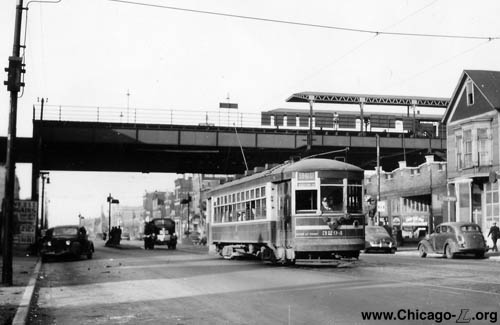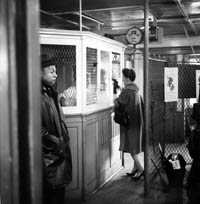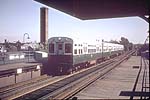|

State station on the Englewood branch is seen in this view looking north on State Street toward the "L" structure and 59th Street beyond. The platform canopy and arrangement is typical of Englewood branch stations. Chicago Surface Lines streetcar 3294 travels south on the 59th-61st route, which connected between its namesake streets via State Street. For a larger view, click here. (Photo from the Scott Greig Collection)
|
State
(5900S/1W)
State Street and 59th
Street, Washington Park
Service
Notes:

|
North-South
Route, Englewood branch
|
Quick Facts:
Address: 5913-15 S. State Street
Established: November 3, 1905
Original Line: South Side Elevated Railroad, Englewood
branch
Previous Names: none
|
Skip-Stop Type:
|

|
Station
|
Rebuilt: n/a
Status: Demolished
History:
|

The interior of State station is seen looking east on October 23, 1962 as a woman pays her fare to the ticket agent. Note the decorative grille on the ticket window and the potbelly stove on the far right. For a larger view, click here. (Photo from Graham Garfield Collection)
|
The Englewood branch of the South Side Rapid Transit began construction in 1903. It opened in segments, beginning November 3, 1905 with a shuttle from the main line at 58th Street to State Street, the first station on the branch. State station was the terminal (and only station) on the branch for about a month. By December 10, service was extended to Wentworth and Princeton (located 61st Street) stations on January 11, 1906. By July 13, 1907, the rest of the line was opened to its terminal at Loomis Blvd.
State station was designed by architect Earl Nielson and built by the American Bridge Company of New York. Like many Englewood stations, it had a mezzanine level station house even though the right-of-way beneath the structure was not used as a public thoroughfare. Two stairways, one on the north side and one on the south, led from the street up to the mezzanine. In between the stairs at street level was a brick commercial building, built at the same time as the station and owned by the South Side Elevated, intended to bring in additional revenue from its rental. As such, the mezzanine was completely obscured from view from the street, making the two stairways flanking the storefront the only visible entrance to the station.
The mezzanine station house's design was unremarkable and functional, with little architectural style to its execution. It was constructed of wood on a steel structure. Its interior was simple, containing an agent's booth built into the wall, a porter's closet, and a restroom. From the back of the mezzanine two stairways led to each of the station's dual side platforms. The platforms were typical of those on the Englewood branch, with wood decking on a steel structure. The canopies were supported from the back of the platform, with steel arched supports and latticework along the back and a hipped corrugated metal roof. Railings were simple and without ornament.
The station survived the CTA's July 31, 1949 North-South service revision and numerous other closings, becoming an "A" station on the CTA's North-South Route. As the neighborhood declined, however, ridership dropped. The station was closed on September 2, 1973 in one of the several rounds of cost-cutting that year that included multiple station closures and service reductions.
In 1992, Wentworth and Harvard,
the next stations west on the Englewood
branch, also closed, creating a gap about two miles long between
stations.


|
cta6483.jpg
(110k)
Car 6483 leads an Englewood "A" train pulling into State
station on October 2, 1972. The station was closed the
following year in a massive service reduction that resulted
in several station closures. (Photo by Steve
Zabel, Collection of Joe Testagrose)
|





